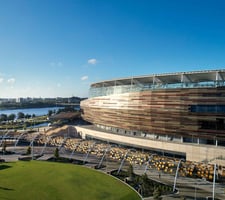Anodising and the environment Anodising is the all-electric transformation of the surface of the...
Australian Aluminum Finishing’s Presentation to AAEC25
Low-Carbon Aluminium Is Just the Beginning: Elevating Sustainability with Smarter Finishes.
Presentation Highlights the Role of Aluminium Finishes in the Net Zero Journey.
At the recent 7th Australasian Aluminium Extrusion Conference in Brisbane, AAF’s Bill Wyllie, Chairman, and Joseph Kalarickal National Technical Manager, presented a bold challenge to the industry: while sourcing low-carbon aluminium is a crucial first step in reducing emissions, the finishing choices applied to aluminium products can make or break long-term sustainability outcomes.
Why Finishes Matter in the Carbon Equation
Aluminium is prized for its strength, light weight, and infinite recyclability. But once it’s extruded into architectural products, it requires finishing—through anodising, powder coating, or other treatments—which significantly adds to its carbon footprint.
AAF’s presentation showcased that:
- Finishes can contribute up to 43% of additional CO₂e emissions of mill-finish aluminium.
- Anodising emits significantly less CO₂e compared to powder coating or PVDF options.
- Durability is critical—the longer a finish lasts, the more sustainable the structure becomes.
Case Studies Prove the Point
- Oxford’s Bodleian Library (UK) features anodised windows from 1940 still in service and forecast to last 135 years.
- Australian heritage landmarks like the ICI House and Sydney’s MLC Building have anodised facades installed over 60 years ago, still performing with minimal maintenance.
- KMH environmental data shows that over a 100-year life cycle, anodised aluminium generates 20–40% fewer greenhouse gases than powder coatings.
New Legislation Demands Long-Term Thinking
With new Australian and global emissions reporting standards (IFRS S1/S2, ASIC and NGER requirements), the carbon cost of a building is now under scrutiny for its entire lifecycle—not just at the point of manufacture or build.
This places greater responsibility on specifiers to understand how finishes affect embodied carbon, serviceable life, and recyclability.
“The true sustainability of aluminium will be judged not just by how it’s made, but how long it lasts.” — Bill Wyllie, AAF
Anodising: Built for the Future
Anodising is an all-electric, electro-chemical process that:
- Enhances durability without adding petrochemical-based materials
- Enables a sealed, colour-stable surface with high corrosion resistance
- Supports decarbonisation as electricity grids transition to renewables
- Adds zero recycling cost or contamination at end-of-life
It’s a finish aligned with net zero goals, particularly when combined with locally sourced low-carbon aluminium.
Updated Standards, Local Quality Assurance
Australia is also aligning with international performance codes for aluminium finishes:
- The new AS 3715:2025 (Powder Coatings) has been updated to incorporate durability and environmental performance. It is anticipated the Anodising AS 1231:2000 will follow suit.
- New classifications for severe environments (like C5 coastal zones) now require ultra-durable fluoropolymer coatings or high-grade anodising.
At AAF, our Australian Institute of Surface Finishing - certified finishes are backed by independent auditing, and robust warranties help specifiers and developers meet these evolving expectations.
Final Takeaway
Low-carbon aluminium is a great start. But the real sustainability wins come from choosing finishes that extend aluminium serviceable life to perform over decades, not just years.
With architectural aluminium now expected to meet not only design expectations but also environmental accountability, the choice of finish is no longer just an aesthetic decision—it’s an environmental one.
AAF continues to lead the charge with durable, emissions-conscious finishing technologies designed for Australia’s harshest conditions and the world’s boldest sustainability goals.
To read full presentation, PDF is available here



